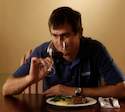More of Coenie Snyman's practical, 'less is more approach to food, and life, in general, is reflected in the nifty little gadget he uses to light a quick braai fire in the built-in hearth on the verandah.

A steel pipe lined with holes is placed beneath a precisely packed boxed pile of firewood, attached to a hose on a small Cadac gas bottle, and lit. No need for firelighters, no problem with wet wood, minimal smoke, very efficient, very Coenie.
Large picture-window sliding doors separate the verandah from the living area. Dominated by a formal, gleaming dark wood dining table and high-backed, upholstered chairs with armrests, it's called 'the boardroom'. The table is a 12-seater that can be added to accommodate up to 20 guests.
Comfortable dining-room chairs are a must. Once you sit down with good food, wine, and friends, you don't want to move.'
'About 10 years ago, we started an annual tradition of hosting a winter solstice dinner on 22 June. Everyone brings a dish. I like to make curries. I usually get someone else to braai so I can be in the kitchen. I can’t be two places at once.' Usually, it's friend Thinus Kruger (red winemaker at Boschendal) who gets inveigled into slaving over the hot coals.
'He’s a very funny man. I was attempting to persuade him to braai for me at one of our get-togethers and he was trying to pass the buck. I told him: "Come on, Thinus, you do a perfect steak!" And he reckons: "No man, I do it f..ing good, Bennie does it perfectly!"' Bennie Liebenberg is The Bergkelder viticulturist.
The other 'boardroom' feature is floor-to-ceiling bookshelves. Coenie's section is dominated by well-thumbed copies and treasured tomes about the world's great outdoorsmen, from Norwegian polar explorer Roald Amundsen to British adventurer Sir Randulph Fiennes and South African hero Mike Horn. 'My man!' says Coenie.
And for something to keep him and others on their toes, he likes to quote from Amundsen’s From the South Pole. 'Having reached the pole ahead of Englishman Robert Scott, Amundsen left a letter for Scott to deliver to the King of Norway on his behalf in case he didn’t make it back safely. And he reckons: “In that one moment, Scott changed from being an explorer to being a postman.”'
 Crème brûlée with compressed chocolate cake recipe by Coenie Snyman paired with Rust en Vrede Shiraz wine....
Crème brûlée with compressed chocolate cake recipe by Coenie Snyman paired with Rust en Vrede Shiraz wine.... Sirloin steak and Béarnaise sauce recipe by Coenie Snyman paired with Rust en Vrede Estate wine....
Sirloin steak and Béarnaise sauce recipe by Coenie Snyman paired with Rust en Vrede Estate wine....